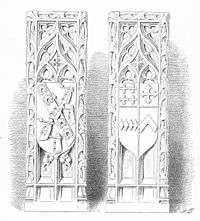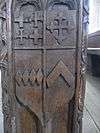St Andrew's Church, Bere Ferrers
| Church of St. Andrew | |
|---|---|
 Church of St Andrew, viewed from the north-west | |
| Location | Bere Ferrers |
| Denomination | Church of England |
| Website | http://www.bereanglicans.org.uk/ |
| History | |
| Founded | 1333 |
| Dedication | Andrew the Apostle |
| Consecrated | 1333 |
| Architecture | |
| Years built | 1290-1340 |
| Specifications | |
| Number of towers | 1 |
| Administration | |
| Diocese | Diocese of Exeter |
St Andrew's Church in Bere Ferrers, Devon, England, has the oldest stained-glass window in Devon, excepting Exeter Cathedral; it is 600 years old. The building was probably built at various times between 1290 and 1340; it is recorded that an archpresbytery was founded here in 1333 and the north transept appears to be the earliest part of the church while the south aisle is the latest, perhaps 15th century.
Features of interest include the Norman font, an unusual altar stone, benches having benchends carved with traceried arches, and an early medieval monument to a knight and lady (probably of the Ferrers family, Latinised as Ferrariis: dative plural). In the church are two other monuments: another recess with effigy of a knight, and a tomb chest of the 1520s, perhaps for Robert Willoughby, 2nd Baron Willoughby de Broke (d. 1521/2).[1] In 1821 the antiquarian draughtsman Charles Alfred Stothard was killed on falling while making a tracing from a window of the church: his tombstone is in the churchyard.
Heraldry
Heraldic bench ends



The church contains late 15th-century oak pews with ornately carved bench ends. Two of these are of especially fine work and interest as they are carved with heraldic escutcheons of the Ferrers and Willoughby families.[2] Each is at the outer end of the central row of pews closest to the chancel. That on the north side shows a bend charged with four horseshoes (fer-de-cheval), being the canting arms of Ferrers, overlaid by three ship's rudders in bend sinister, the badge of the Willoughby family, inherited from Cheyne, as evidenced by an appearance on the earlier Cheyne tomb at Edington Priory, Wiltshire. Further rudders are shown in the field, one in base, one in sinister. That on the south side shows the arms of Willoughby de Broke, quartered as on the tomb of Robert Willoughby, 1st Baron Willoughby de Broke (d.1502) at Callington, Cornwall, with some details omitted in the wood-carving. The full blazon is: Quarterly, 1st grand quarter quarterly, 1st and 4th a cross crosslet double crossed [3] 2nd and 3rd a cross moline; (Willoughby) 2nd grand quarter, a cross fleurie (Latimer) 3rd grand quarter, 4 fusils in fess each charged with an escallop (Cheyne) 4th grand quarter, a chevron within a bordure engrailled (Stafford).
Heraldic roof-bosses

The junctions of the oak beams of the ceiling of the south porch are embellished with several oak bosses, some of which display carved armorials of the ancestral families of Willoughby, as shown within the bench-end escutcheons, namely Ferrers, Latimer and Cheyne. Also shown here are the arms of the Gorges family of Knighton, Isle of Wight and Wraxall, Somerset,[4] from a co-heiress from whom the Cheyneys were descended, blazoned as Argent, a gurges azure. A gurges is a form of canting arms, being Latin for a whirlpool, depicted as a whorl.
References
- ↑ Pevsner, N. (1952) South Devon. Penguin Books; pp. 47–48
- ↑ Rogers, pp.32–3
- ↑ The cross crosslet double crossed can be seen clearly on the tomb of Robert Willoughby, 1st Baron Willoughby de Broke at Callington Church, Cornwall. It was mis-drawn and mis-blazoned as a cross engrailled by Rogers. The Bere Ferrers bench ends, where perhaps the wood does not allow great detail in carving, shows not a cross crosslet but rather a thick plain cross
- ↑ The senior branch of the Gorges family, distant relatives of the Gorges of Wraxall, married an heiress of the Foliot family of Tamerton Foliot, almost directly across the River Tavy from Bere Ferrers
Coordinates: 50°27′01″N 4°10′17″W / 50.45025°N 4.17143°W